Abstract
A city is a complex, dynamic and nonlinear system, full of different hazards. These hazards affect all elements of the system, and it is necessary to reveal and monitor the activities that promote growing the hazards into real dangers, i.e. it is necessary to conduct research on “urban hazards” and learn to manage them. Systems characteristics, becoming more and more complicated, often do not match human capabilities. Quite often human factors, though playing the key role in systems operation, are taken into consideration only during the use of systems, but over the design stage often the simplest human characteristics are not taken into account. The underestimation of human factors considerably reduces operational safety of residential areas. It has been arisen the situation when one of the most important sections stands aside the developers attention, which negatively affects forecast of residential areas operation. The authors argue that it is necessary to carry out interagency and system risk analysis for efficient functioning of the technogenic threats management at the municipal level taking into account their interrelation.
Keywords: Complex technical systemsurban hazardsgraphic-analytical method for the analysis of risk
Introduction
Currently the technogenic threats are becoming more complex. The object or subject is at once exposed to a number of factors that are much more dangerous than the independent impact of these factors.
To the special features of today's emergencies and negative influences also applies the consequences of the realized hazards, that can be saved for a long time and influence few generations of people. All this leads to the necessity of a sensible and reasonable approach to the analysis of complex territorial risks that characterize the real state of public safety and the environment in each region (Moiseev, 1988)
Problem Statement
Anthropogenic impacts on biota has important features (Nikolaikin, 2003): the non-linearity of the dose effect of different foreign substances or radiation on biological systems, that is, as a rule, the effect of low doses is often disproportionately strong; the cumulative effect of any long-term impacts on the natural objects (organisms, ecosystems and so forth.), that is, a significant increase and accumulation of action subsequently often leading to a sharp qualitative changes by adding weak quantitative shifts; synergistic (shared) effect of various environmental factors on the living, which often leads to unexpected effects, that are not the sum of the responses to the rendered action.
These features as well characterize and the technical systems too (small cracks may eventually induce significant effects, the accumulation of latent damage, aging of materials, fatigue dynamic processes in structures can lead to abrupt qualitative changes, the combined effect of various factors depending on the combination and exposure sequence can lead to different consequences, individual differences, even the same type of technical systems due to "age" and operating features to the action of environmental factors; any impact, "which found" weakest link in the technical system can lead to a chain reaction of failures, etc.)... A characteristic feature of synergistic processes, in addition to the negative effects is a delay in time of their appearance of mutual reinforcement is a time lag of their appearance in comparison with the stimulating factors (Ragozin, 2003).
The existing safety passports of the territories are intended to assess the possibility of emergencies, assessment of the consequences for the population, territory, facility and stuff, as well as the development of risk reduction activities and the weakening of harmful effects in emergency situations on the territory, readiness assessment for liquidation of emergency situations, etc. The main difficulties in the development of Safety passports are associated with the analysis of risk of possible emergencies and the damage forecast. The passport itself – is only a few pages, but the calculating and explanatory note to it – a thorough multi-page document (October, 2006). Speaking about the security of the territories, we must not forget that they are, from a thermodynamic point of view, cannot be detached from the flows of mass, energy and information, which, in turn, can be both stabilizing and destabilizing factors for security.
During the analysis and assessment of risks the distinguish between potential and situational danger must be taken into account and (Pushkin, Emelyanov, 2005). A potential danger – is the possibility of certain events happening that lead to undesirable consequences. Depending on the time this situation occurs, the severity of the consequences can be different. The situation that is contributing in varying degrees to the development of such events, is a situational danger. Quite the opposite course of events is also possible – from immediate response to protect the realization to the potential danger to provoking serious consequences.
The presence of a situational risk is a destabilizing factor affecting the safety of people, environment and economy. This requires a more comprehensive analysis and consideration of forming situational risk factors (anthropogenic, natural or a combination) to the possibility of organizing their management.
Research Questions
Risk analysis of the territories before all contains insurmountable uncertainty. There are many reasons: an endless number of system elements called "territory" (macro – and micro world of animate and inanimate nature); the endless number of causal relation-ships (mostly unknown) as between elements of the system itself, so elements of other systems (territories); the random factors of the events as the result of accidental circumstances, random forces; possible secretive formation and development of risk factors, etc.
Therefore, in general case, the "territory" is a complex, dynamic, substructuring, non-linear system, "stuffed with" all sorts of dangers.
All hazards can be divided into the following three classes (Belov, 2003)
1) the naturaly-environmental, caused by the disruption of the natural cycles of substance migration;
2) the technogenically-production, related to the possibility of unwanted energy emissions and harmful substances accumulated in technological objects created by human beings;
3) the anthropogenically-social, caused by intentional concealment and / or distortion of in-formation. In our opinion, also it is necessary to add: "or ignorance, for various reasons, the real situation".
Speaking of the scenarios of possible emergencies at the facility level, it is necessary to emphasize that every dangerous object usually has its own characteristics, its own set of project and non-project accidents and disasters. Actual means of mathematical modelling for most of them (explosions, chemical spills of hazardous substances etc.) allow you to define a typical accident scenario, a typical vision of its different stages.
Based on this knowledge, it is easier to plan rescue operations. As a rule models allow to find out vulnerabilities of a particular company or area, which are necessary to be secured firstly. In many specific cases the analysis of these models helps to understand how to do monitoring for a particular object.
We should pay attention to one important fact. Risk assessment decisions are based on the information about the probabilities of different possible outcomes and the possible damage that requires a very high level of knowledge of the studied objects, technologies, solutions. However, in many cases, the level of modern science does not allow to have such information and assess risks, leaving a considerable degree of uncertainty. In these circumstances, the level of risk assessment can be carried out only approximately using a combination of different methods – the method of expert evaluations; statistics; method for creating scenarios with analytical studies, using approaches based on fuzzy logic.
Expert methods are suitable in cases when there are no data about the frequency of symptoms and obscure the logic of their origin and development. As a rule, they are applied in the assessment of the probability of accidents and catastrophes, when the chain of elementary events is so complex that it is impossible to form an adequate their correlation structure, allowing to estimate the probability of the resulting adverse events (Silaev, Nedostup, Khaustov, 2006).
The main difficulty will be in building a chain of possible events that may be realizable only in a particular area at a particular set of circumstances. Among the many possible scenarios of emergencies there can be either rather obvious, so and difficult to predict. It could be anticipated only by highly qualified experts as the root cause at first meaning can be "trivial events".
The theory of risk (risk theory) provides a solution for similar problems in different are-as of our lives. Risk theory is the theory of decision making under probabilistic uncertainty. From a mathematical point of view, it is a branch of the theory of probability, and applications of risk theory are almost unlimited. The financial area of application is mostly advanced: banking and insurance, management of market and credit risks, in-vestments, business system. Non-financial applications associated with threats to health, the environment, risk of accidents and enviro, procedures and practical measures in solving the problems or reducing the risk of industrial accidents for human life, illness or injury, damage to property and the environment. Several names in mental disasters are developing as well (Silaev, Nedostup, Khaustov, 2006). In risk studies, there appeared a separate branch under the title "risk management".
In technosphere the risk management is a part of systematic approach to making decisions for the risk management process exist in our country (industrial safety) and abroad ("safety management", "management of process hazards"), which are actually synonyms. Under these terms refers to a set of measures dew to reduce the level of technological risk, potential material losses and other negative consequences of accidents.
It is also necessary to understand the basic difference between the concepts of "risk assessment" and "risk management". Risk assessment is based on the fundamental, first of all natural-science and engineering, studying the source (e.g. chemical objects) and risk factors (e.g., pollutants, taking into account characteristics of specific technologies, and environmental situation) and the mechanism of interaction between them. Risk management is based on economic and social analysis, as well as the legislative frameworks that are not needed and are not used in the risk assessment. The risk management deals with the analysis of alternatives to minimize the risk, it is a special case of the class of multicriteria problems of decision making under uncertainty. Risk assessment provides the basis for the research and development of measures to control risk.
In terms of works connected with problems of risk, the term "riskology" is used the meaning of which is interpreted by the authors in different ways:
- Janicki, (2004): "the Subject riskology – is not risks and their consequences, not disaster, it is a society which is inherent in the production, distribution and consumption of risks";
- Otkidach, Dzhura, Pisarenko, (2006): "... the science about the risk is needed. This science is riskology. Riskology – the science about future because it is concerned with predictive assessments, possible outcomes, future disasters";
- Gordukalov notes that "riskology" is often called the overall direction of the risk analysis of any planned activity and currently is in the process of its formation.
In our opinion, for the better risk analysis of urban areas it is possible to use the concepts and instruments, interpreted in "Applied technospheric riskology" (Romanovsky & Muraveva, 2007).
Applied technospheric riskology – interdisciplinary branch of science synthesizing theoretical and practical experience of Sciences about surrounding world in development of conscious use of knowledge about synergies, technological, environmental, social and other factors in risk management of difficult technosphere complexes.
Purpose of the Study
Despite the abundance of the researches in the technosphere safety systems, the problem of choosing ensuring research methods remains relevant. Particularly, the construction of the event trees does not accept to include in the chain of development the effects of possible scenarios to the possible developments. The human factor is guilty in most accidents, so in risk analysis this impact of it is best veiled in statistical information on historical incidents.
The event tree, in general, differs from a decision tree, that is not adapted to the analysis of human actions in certain conditions as the decision tree is not adapted for developments in the technosphere system. The authors hope that graph-analytical method of risk analysis will allow to connect the "unconnected" (the method of prof. Romanovsky).
Research Methods
The method of "Tree structure" allows clearly formalize the considered material; to analyze various situations; analyze different but related situations and events within a single tree; to conduct effective quantitative evaluation of conditions to prevent negative events or conditions to achieve the goal; to consider all elements of the system "man-machinery-environment" equally in a single tree.
The tree structure is a graphical representation of the relationship of the various specific events in the system "man-machinery-environment".
Event – is a condition, occurrence, phenomenon, action that could occur, has occurred or may occur in the system or element.
The event, as a purpose of the analysis, called the head or resulting. The head event occurs as a result of a combination of various events. In the tree structure, there may be several head events. In addition to strictly deterministic cause-effect relations, inverse relations in a tree structure are possible too, when the head event (or intermediate) affects the previous one.
Events that cause the processes in the system and eventually are leading to the occurrence of head events, are called primary or original.
Events located on the tree structure between the head and the primary events are called intermediate.
Any event indicated by the symbol with the notes inside it:
Quantitative analysis is determining values for risk of adverse events, evaluation of the effectiveness of different interventions aimed to reduce risk and select appropriate solutions.
Quantitative analysis consists of determining the probability of occurrence of the final head events after building the tree structure that meets the purpose of the analysis, the odds of the starting (initial) events.
A quantitative measure of the initial events is chosen on the basis of available statistics, expert estimations or other methods. Calculations are done for all the branches of the tree structure.
The relations between events of the structure denoted by the logical connections or operations:
1) Operation "And":

The output event in this case occurs only when the implementation of all input events. The number of input events is more than one.
The concepts of "input event", "output event" hereinafter serve only to explain the quality of communication between them using an operation and are not concepts most of the tree structure.
In the case of the Operation “And” for an n input events which are statistically independent the probability of the output event is determined by the rule of multiplication of probabilities.
where
2) the Operation “Or”:

The Output event occurs when at least one of the input events is implementing. The number of the input events more than one.
For statistically independent events, united the operation "OR", the probability of the event output in general is:
3) the operation " Σ", (set of events):

The Operation «Σ» is applied when the effect of the input events to output can not be clearly attributed to one of the previous two ("AND" or "OR"). The output event occurs when cumulative impact of the input events to output exceeds a certain threshold. The number of the input events more than one.
In the case of the operation «Σ» probability of the output event is defined as follows:
where
In addition, for the operation «Σ» normalization condition must be performed:
In essence, the operator "set of events" is a formal neuron.
In recent years, a new branch of mathematics devoted to artificial neural networks is greatly developing.
The relatively simple elements are the basis of the neural networks and imitate the brain neurons. The neuron means formal neuron. Neuron has a group of synapses - unidirectional input links and axon - an output connection.
General view of the formal neuron is shown in Figure
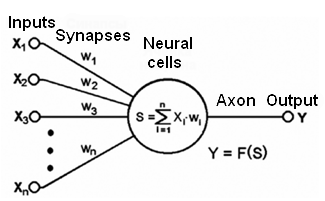
Each synapse is characterized by the value of synaptic connections or its weight wi, describing throughflow capacity of the channel and assess the degree of influence of the signal from the input to the output. The current state of the neuron is determined as the weighted sum of its inputs.
The output signal of the neuron is a function of its condition Y = F(S). The function F is called activation and may have a different purpose, depending on the conditions of use of a specific neuron in the network.
Depending on the application of the specific neuron, its output signal can be analog or digital (1/0 or Yes/no).
In the graphical analytic method of the technosphere risk analysis the neuron appeared.
4) Operation "->" (cause - effect):

Operation "-> "is used to simplify the chain of events in the specific system "man - machinery - environment" in the case where there is a clear relations between input and output events.
Operation "->"in some cases, may be replaced by one of the operations
"And - Cause", "OR - Reason", "Σ - Cause" depending on the specific situation:
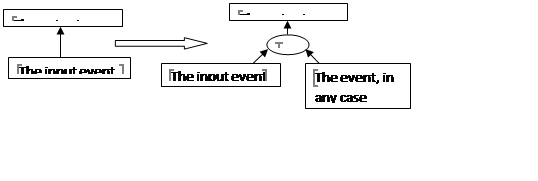
This can be useful for analyzing the reasons for the emergence of "mandatory" events in a specific system.
In the case when the input event initiates the implementation of several output events, a graphical representation of the operation "->" looks like:

For the operation "->" (cause and effect) the probability of the output event looks like:
Poutput =W Pinput .
Here
1 ≥
When output events are more than one the influence of input events on each output is estimated individually.
5) the Operation "the qualifying event":
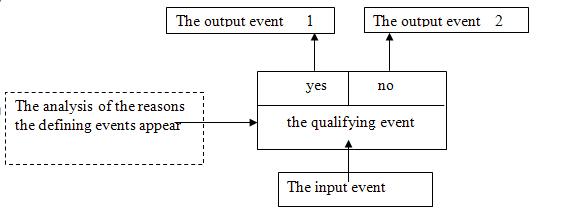
If the input event is implemented further developments will occur in the branch "Yes" (the implementation of the "Output event 1") or along the branch "No" (the implementation of the "Output event 2") depending on implemented in a particular case specifying the event or not. If it is necessary, the analysis of the causes implementing the defining event in the tree structure is conducted.
Operation "qualifying event" is a kind of condition of implementation of each of the two alternative events.
So the input event is Implemented with a probability of P
The probabilities of the output events are defined by the following relations
Poutput1 = Pd.e . · Pinput ;
Poutput2 =(1 – Pd.e .) · Pinput ,
because the alternative output events form a complete group of events.
For introducing clarifications to related events and other events that do not directly affect the course of events, you can use the symbol:
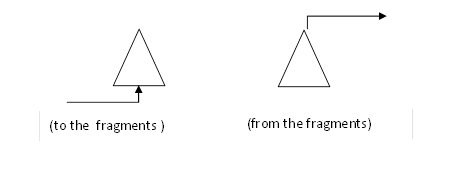
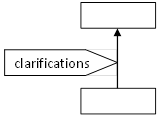
The tree structure can be divided into separate fragments. A single logical structure used to move the character serial number inside the transition to connect the fragments in it:
Building a tree structure begins with the processes of synthesis and analysis, which includes several procedures.
The synthesis process involves identifying the purpose of the analysis, the choice of a specific system "man-machinery-environment" to enable analysis to achieve the goal. The analysis process is performed by methods of induction and deduction.
As an example, we present the results of qualitative analysis of safety conditions of objects in residential areas (Fig.
We can say that in this case we are talking about a new kind of technology risk management, considering and deciding a wide range of related issues (technical, environmental, socio-economic, informational, political, etc.) to identify "weak" spots in existing or created by the technosphere, the systems for the subsequent optimization of security measures and reduce the probability of occurrence of emergency situations natural and technogenic character.
Findings
Why is the method of "tree structure" is considered by the authors as a system-forming factor of applied technospheric riskology?
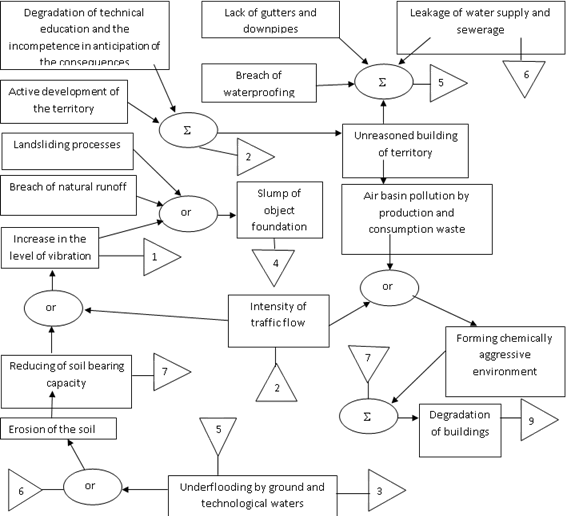
Firstly, the method of "Tree structure" absorbed graphoanalitical method precursors and is an extension development of them. In particular, there may be a few head events; the impact of future events is permitted to the previous ("scrolling" of the events in time); development on different "branches" of the structure as response to changes of the current situation.
Secondly, it is possible to equal record of all components of the "human-technology-environment" system within a single structure.
Thirdly, the operator ‘set of events’ appeared. This allows more easily include aspects of psychology, economics and other disciplines in the analysis.
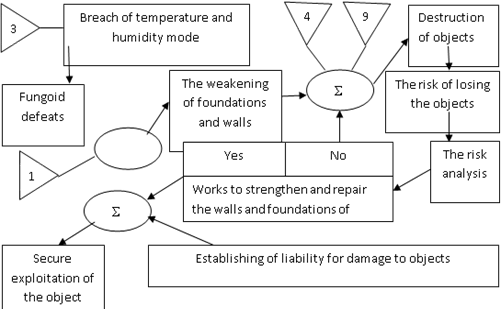
Fourth, not complete, but rather an exemplary tree structure more voluminous then (if may say so) principle setting circuit according to which it was created. The reason is that the ‘structure’ requires a clear formalization of the problem.
Conclusion
The method of ‘Tree structure’ allows: clearly formalize the material under consideration; analyze various situations; analyze different but related situations and events within a single ‘tree’; conduct an effective quantitative assessment of the conditions to avoid adverse events or conditions to achieve goals; equally, within a single ‘tree’, take into account all elements of the system ‘human-technology environment’.
Difficulties and advantages of this method are as follows. The difficulty is that it is necessary to clearly understand all the intricacies of the problem, to be able to separate the main thing, to be able to combine all events in a single structure. The advantage is that logical structure built ‘does not allow to’ miss from consideration some important points; it demonstrates the important relationship of events. Life is changing, changing our knowledge of it, and, dare to hope, the content of MSDS and Russian territories’ regional and municipal governments will be more fully meet the objectives of our common security.
Acknowledgments
The work is performed according to the Russian Government Program of Competitive Growth of Kazan Federal University.
References
- Belov, P.G. (2003) System analysis and modeling of dangerous processes in the technosphere: Studies. a manual for students. ouch. proc. Institutions. Moscow: Publishing center "Academy".
- Moiseev, N.N. (1988) Ecology of mankind through the eyes of mathematics: (Man, nature and the future of civilization). Moscow: Mol. guard.
- Pushkin, Yu., Emelyanov, A. (2005). Account of potential synergies and situational risk in the management of technogenic risks. In the collection scientific reports and articles of the 1st International conference "Safety. Technology. Management." Part I. Togliatti: Togliatti state University.
- Ragozin, A.L. (2003) Assessment and management of natural risks. Thematic volume / edited by. Moscow: Publishing firm "KRUK".
- Romanovsky, E.V., Muraveva E.V., (2007). Applied the technosphere riskology: scientific publication. Kazan: RIC "School".
- Silaev, V.A., Nedostup, P.Y., Khaustov, A.P. (2006). Assessment of the anthropogenic component of the environmental risks of gas turbines. Ecology and industry of Russia, January.
Copyright information

This work is licensed under a Creative Commons Attribution-NonCommercial-NoDerivatives 4.0 International License.
About this article
Publication Date
31 August 2017
Article Doi
eBook ISBN
978-1-80296-028-0
Publisher
Future Academy
Volume
29
Print ISBN (optional)
-
Edition Number
1st Edition
Pages
1-960
Subjects
Teacher, teacher training, teaching skills, teaching techniques
Cite this article as:
Romanovsky, V. L., Gorbunova, O. A., & Dobrotvorskaya, S. G. (2017). Residential Areas Risk Analysis. In R. Valeeva (Ed.), Teacher Education - IFTE 2017, vol 29. European Proceedings of Social and Behavioural Sciences (pp. 705-717). Future Academy. https://doi.org/10.15405/epsbs.2017.08.02.81

